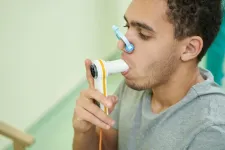(Press-News.org) Peer-reviewed – Proof-of-concept study
University of East Anglia researchers have made a significant breakthrough in ocular device technology with the introduction of a novel resin for 3D printing intraocular devices. This innovation has potential to enhance the manufacture of eye implants universally used in cataract and refractive surgeries.
An artificial intraocular lens (IOL) is primarily required for people with cataracts, a condition where the eye’s natural lens becomes cloudy, obscuring vision.
They can also be also used to correct refractive errors such as myopia (nearsightedness), hyperopia (farsightedness) and presbyopia (when eyes gradually lose the ability to see things clearly up close, as a normal part of aging).
Lead author Dr Aram Saeed, Associate Professor in Healthcare Technologies at UEA's School of Pharmacy, said: “For the first time, we have developed a resin that can be used to print ocular devices directly.
“While still in the early stages, the ability to 3D print these lenses could significantly enhance eye care for patients by offering unprecedented levels of customisation and design precision, potentially leading to better clinical outcomes.”
Historically, IOLs have been made from a variety of materials, including glass and silicone, although more recently the industry has significantly evolved to predominantly use acrylic materials.
Currently hydrophilic and hydrophobic acrylic are the most commonly used materials due to their excellent optical clarity, flexibility, biocompatibility with the body and for their stability and safety within the eye.
Current methods of making IOLs use lathing and moulding techniques. While these methods offer the production of well-engineered and high-optical quality devices, they also come with inherent limitations, particularly in terms of design complexity and customisation.
Dr Aram Saeed said: “3D printing could significantly enhance the production of ocular devices, not only improving speed and precision in manufacturing but also enabling greater complexity and customisation in design.
“Our proof-of-concept paper is the first in a series that will detail our developments in this area and set the stage for transforming eye care practices globally.
“Our work combines material science with healthcare technology and requires extensive know-how in developing these types of ocular devices.
“As we continue to publish our findings and share our advancements, we aim to be at the forefront of the industry, working with industrial partners and researchers worldwide to refine and enhance the technology."
Although still in the early stages of development, the innovation could potentially have several advantages:
Tailored Lenses: 3D printing could create lenses customised to each patient's eye shape and vision needs, potentially improving vision correction and comfort.
Faster Production: Compared to traditional methods, 3D printing has the potential to enable quicker design, testing, and manufacturing of lenses. This speed could reduce the time between diagnosis and surgery, providing faster care to patients.
Complex Designs: 3D printing makes it possible to create intricate lens shapes that were previously difficult to manufacture. These designs could better address a wider range of vision problems.
Cost Reduction: By using 3D printing, the production cost of custom or high-quality lenses may decrease, making them more affordable for more patients, particularly in economically disadvantaged regions. This could lead to better overall public health outcomes.
Compatibility with Imaging: The researchers hope that combining 3D printing with advanced imaging technologies in the future could help produce lenses that fit individual patients' eyes optimally, reducing the need for adjustments or complications after surgery.
Material Innovation: 3D printing allows for the development of new materials with improved optical performance. This could result in lenses that not only correct vision but also enhance it.
The study found that the 3D printed lenses have good optical clarity, can be folded, and implanted into a human capsular bag.
Co-author Michael Wormstone, Emeritus Professor at UEA’s School of Biological Sciences, said: “If successful in further developments, this new technology could transform the industry by enabling portable manufacturing solutions, especially beneficial in remote and economically disadvantaged areas.
“It also has the potential to support the production of premium, customised lenses that could enhance surgical outcomes in more advanced healthcare settings."
The team's efforts have been recognised with the awarding of a United States patent, assigned to UEA Enterprise Limited, a business entity of the university focused on fostering innovation and commercialising research.
The UEA researchers continue to work closely with industry partners to refine the technology.
For example, further work has been underway to ensure the process works accurately on a larger scale and to increase the printing resolution to improve the dimensional accuracy.
It is hoped that clinical trials could start in the next few years.
Dr Saeed and Prof Wormstone have a strong partnership with the ophthalmology department at Norwich and Norfolk University Hospital (NNUH), which brings valuable clinical insights and visionary approaches to their work, with both UEA and the hospital members of the pioneering Norwich Research Park.
Mr Anas Injarie, a leading consultant ophthalmologist at NNUH with more than 20 years of experience, said: "This innovation has the potential to enable the production of lenses that match patient specifications in design and optical performance.
“For premium markets, it represents an exciting possibility to provide tailored treatments that could enhance patient satisfaction and surgical success."
The research was funded by the University of East Anglia through the Innovation Development Fund and Proof-Of-Concept grants; the Humane Research Trust; and the Engineering and Physical Sciences Research Council (EPSRC).
Further funding was provided by UEA’s Impact Acceleration Account (IAA) funding from the Medical Research Council (MRC).
‘Stereolithographic Rapid Prototyping of Clear, Foldable, Non-refractive Intraocular Lens Designs: A Proof-of-Concept Study’ is published in the journal Current Eye Research.
END
Innovative 3D printing could revolutionise treatment for cataracts and other eye conditions
2024-05-20
ELSE PRESS RELEASES FROM THIS DATE:
Rigid approach to teaching phonics is ‘joyless’ and is failing children, experts warn
2024-05-20
Experts have released robust research to show that phonics should be taught hand-in-hand with reading and writing to encourage true literacy and a love of reading, not through narrow synthetic phonics.
There is widespread disagreement globally across academic and educational spheres about the best way to teach children to learn to read and write. Despite a growing international trend towards a narrow approach to synthetic phonics, experts suggest there is a ‘better way’ to teach reading and writing.
In England, the system is among the most prescriptive in the world with ‘synthetic phonics’ being the ...
Meerkat chit-chat
2024-05-20
EMBARGOED UNTIL MONDAY, 20 MAY 2024, 01:01 CEST (00:01 BST/London Time)
Meerkats use two different types of vocal interactions to stay in touch with their group mates. Sometimes the call simply broadcasts information, whereas other times meerkats engage in a call exchange with their neighbours, as researchers from the Centre for the Advanced Study of Collective Behaviour at the University of Konstanz and the Max Planck Institute of Animal Behavior present in a new publication published on 20 May in Philosophical Transactions of the Royal Society B.
What does it sound like ...
Extreme heat associated with children’s asthma hospital visits
2024-05-20
EMBARGOED UNTIL: 2:15 p.m. PT, May 19, 2024
Session: A95 – Climate Change and Health Disparities in Lung Disease
Extreme Heat and Asthma Hospitalizations in Children in California (2017-2020)
Date and Time: Sunday, May 19, 2024, 2:15 p.m. PT
Location: San Diego Convention Center, Room 24A-C (Upper Level)
ATS 2024, San Diego – For children seeking care at a California urban pediatric health center, extreme heat events were associated with increased asthma hospital visits, according to research published at the ATS 2024 International Conference.
“We found ...
Poor access to in-home nursing for medically complex children quantified
2024-05-20
EMBARGOED UNTIL: 2:15 p.m. PT, Sunday, May 19, 2024
Session: Session A96 – Improving the Care of Patients with Diverse Pulmonary Conditions and Sleep Disordered Breathing
The State of Home Health Nursing for Medically Complex Children in the United States
Date and Time: Sunday, May 19, 2024, 2:15 p.m. PT
Location: San Diego Convention Center, Room 8 (Upper Level)
ATS 2024, San Diego – For American families with medically-complex children, access to home health nursing is often inadequate and the families face major financial burdens, according to research published ...
Hormone Replacement Therapy (HRT) may improve pulmonary hypertension and right ventricular function
2024-05-20
EMBARGOED UNTIL: 2:15 p.m. PT, May 19, 2024
Session: A97 – It’s (Not) a Small World: Molecular and Physiologic Epidemiology in PAH
The Impact of Reproductive History on Pulmonary Hypertension: Insights from the Pvdomics Study
Date and Time: Sunday, May 19, 2024, 2:15 p.m. PT
Location: San Diego Convention Center, Room 6D (Upper Level)
ATS 2024, San Diego – The use of hormone replacement therapy (HRT) may be associated with improved pulmonary hypertension in women, according to research presented at the ATS 2024 International Conference. Pulmonary hypertension (PH) is a type of pulmonary vascular ...
Hospitals caring for diverse patient populations have higher mechanical ventilation mortality
2024-05-20
EMBARGOED UNTIL: 2:39 P.M. PT, May 19, 2024
Session: A93 - CRITICAL CARE AND ACUTE CARE MEDICINE: DISPARITIES, QUALITY IMPROVEMENT, AND OUTCOMES
Examining the Association Between Hospital Environments and Intersectional Disparities in Mechanical Ventilation Outcomes
Date and Time: Sunday May 19, 2024, 2:39 p.m. PT
Location: San Diego Convention Center, Room 7A-B (Upper Level)
ATS 2024, San Diego – The odds of death for patients receiving mechanical ventilation for pneumonia or sepsis increase along with the diversity of hospitals’ patient populations, suggesting more systemic factors such ...
Spirometry clinical trial eligibility may differ with race-neutral equations
2024-05-19
EMBARGOED UNTIL: 9:15 a.m. PT, May 19, 2024
Session: A27 – Emerging Treatments and Therapeutic Strategies in COP: Results of Clinical Trials and Observational Studies
Impact of Race-Neutral Spirometry Reference Equations on Eligibility for Chronic Obstructive Pulmonary Disease Clinical Trials
Date and Time: Sunday, May 19, 9:15 a.m. PT
Location: San Diego Convention Center, Room 33A-C (Upper Level)
ATS 2024, San Diego – Equations that don’t use racially and ethnically adjusted spirometry results to help determine eligibility for chronic obstructive pulmonary disease (COPD) ...
World-first trial shows benefits of finding, treating undiagnosed asthma and COPD
2024-05-19
Finding and treating people with undiagnosed asthma or chronic obstructive pulmonary disease (COPD) improved their health and reduced their healthcare visits for respiratory symptoms in the year after diagnosis, according to a world-first clinical trial published in the New England Journal of Medicine.
"It's estimated that 70 per cent of people with asthma or COPD go undiagnosed." said study lead Dr. Shawn Aaron, a senior scientist and lung specialist at The Ottawa Hospital and professor at the University of ...
Acetaminophen shows promise in warding off acute respiratory distress syndrome, organ injury in patients with sepsis
2024-05-19
A National Institutes of Health (NIH)-supported clinical trial has found that intravenous acetaminophen reduced sepsis patients’ risk of having organ injury or developing acute respiratory distress syndrome, a serious condition that allows fluid to leak into the lungs. Sepsis is the body’s uncontrolled and extreme response to an infection. While the trial did not improve mortality rates in all patients with sepsis regardless of severity, the researchers found that acetaminophen gave the greatest benefit to the patients most at risk for organ damage. With the therapy, those patients needed less assisted ...
Bisoprolol in patients with COPD at high risk of exacerbation
2024-05-19
About The Study: Among people with chronic obstructive pulmonary disease (COPD) at high risk of exacerbation, treatment with the β1-selective β-blocker bisoprolol did not reduce the number of self-reported COPD exacerbations requiring treatment with oral corticosteroids, antibiotics, or both.
Quote from corresponding author Graham Devereux, M.D.:
“People with COPD are at increased risk of cardiovascular conditions that benefit from treatment with beta-blockers. However, there is a well-documented ...





